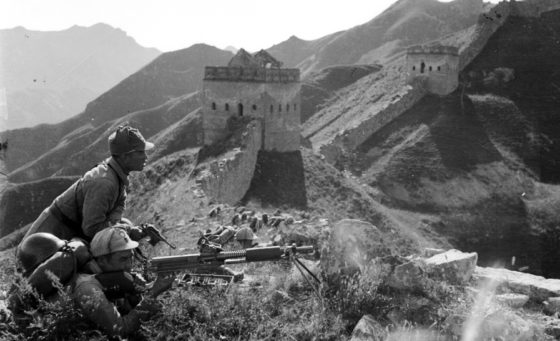
“Germany’s depleted armaments industry was still able to crank out a sizeable arsenal of makeshift firepower for the Volkssturm.”
BY LATE 1944, the collapse of the Third Reich was only a matter of time.
The Western Allies were closing in on Germany from one side; the Red Army was advancing from the other. With his war machine in utter disarray, an increasingly unstable Adolf Hitler insisted that salvation lay in the hands of the Volkssturm — the Nazi party’s people’s militia.

Comprised of nearly six million non-serving civilian males between the ages of 16 and 60, this slipshod conscript army was expected to smash the Bolsheviks at the very gates of the German capital in a glorious decisive battle. And according to the delusional propaganda minister, Dr. Joseph Goebbels, what Volkssturm formations lacked in combat experience and training they would more than make up for with ideological zeal and fanatical loyalty to National Socialism. Accordingly, the units weren’t even under military control; they were commanded by the party itself.
And while these ad hoc home guard battalions marched off to certain defeat with whatever mothballed and obsolete weapons that could be scrounged, Germany’s depleted armaments industry was still able to crank out a sizeable arsenal of makeshift firepower for the Volkssturm. Consider these weapons of last resort:

The Volkspistole
The Volkspistole or “People’s Pistol” was a crude 9mm handgun that was to be mass-produced and distributed to militia units, as well as Germany’s civilian population in advance of the 1945 Allied invasion of the Fatherland. Slated to be manufactured by Mauser as well as Walther, the two-and-a-half-pound (1 kg) pistol featured an eight-round magazine and had an effective range of about 50 m (150 feet). The war ended before the weapon could be produced and distributed in large numbers. Examples of the gun that survived the war are still traded among firearms collectors.

Hitler’s Sten
Germany was so impressed with Britain’s miracle Sten gun, they stole the design and produced their own version of the famous $10 sub-machine gun. In fact, the MP 3008 was a near-perfect knock off of the iconic Mk. II Sten, save for its vertical magazine port — the Allied weapon was loaded through the side. Simple, but effective in close quarters, the MP 3008 was well suited to the urban warfare that marked the final days of the Third Reich. More than 10,000 MP 3008s were manufactured and distributed to Volkssturm formations before the German surrender.

The People’s Assault Rifle
By the last year of the war, infantry rifles were in such short supply in Germany that home army units had to be equipped with a series of improvised weapons like the Gustloff Volkssturmgewehr, or “People’s Assault Rifle.” Chambered to fire the same 7.92 mm round that went into the revolutionary MP-44, the semi-automatic weapon was effective to about 300m (900 feet). Made of fewer than 40 components, half of which were constructed out of cheap stamped metal, the Volkssturmgewehr was both simple and inexpensive to manufacture, but was reputed to be unreliable and inaccurate. More than 10,000 were produced before the war’s end. Other Volkssturm rifles included the bolt-action VK-98 and the VG-1 and VG-2.
The Panzerfaust

Although in service with the regular army and Waffen SS since 1942, the Panzerfaust or “tank fist” was also liberally distributed to the soldiers of the Volkssturm. The 13-lb. single-shot, rocket launcher required virtually no training to operate, but its melon-sized, fin-stabilized warhead could punch a hole in any Allied armoured vehicle on the battlefield from distances of up to 150 metres. While only marginally effective in open country, the weapon was devastating in urban settings. In fact, during the Red Army’s 1945 invasion of Germany, up to 70 per cent of the Soviet tanks that were destroyed in action were taken out by man-portable weapons like the Panzerfaust. [1] Upwards of 6 million rolled off assembly lines between 1942 and the war’s end, the most plentiful variants being the Panzerfaust 60 and Panzerfaust 100.

Throw-away flamethrowers
Like the disposable Panzerfaust, the Einstossflammenwerfer 46 was a bargain-basement flamethrower that operators could use once and then discard. Designed to be handled by novices, the weapon could squirt a single one to two-second burst of flame up to 90 feet. Although manufactured in quantity for the home army, the weapon also founds its way to frontline units.
BONUS: The Volksjäger

While certainly not a part of Hitler’s militia units, the Heinkel He-162 Volksjäger or “people’s fighter” was another by-product of the Third Reich’s late-war emergency weapons program. Amazingly, the mostly wooden, jet-powered interceptor went from drawing board to production in a staggering 38 days beginning in the fall of 1944. It entered combat in early 1945. A total of 320 of the innovative aircraft were produced before the capture of Berlin, and despite its ad hoc design and construction, the 162 became the fastest combat aircraft of the war, topping out at 905 km/h (562 mph). Equipped with two 30-mm cannons, the Heinkel jet chalked up at least one victory in the final three weeks of the war before chronic fuel shortages and a lack of serviceable runways grounded the entire fleet. A handful of the aircraft survive as museum pieces in Canada, the U.S., France and Great Britain.
(Originally published on MilitaryHistoryNow.com on May 23, 2014)










1 thought on “Weapons of Last Resort – The Arms and Equipment of Hitler’s ‘Volkssturm’”